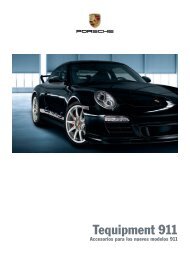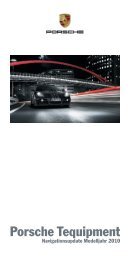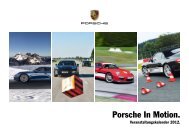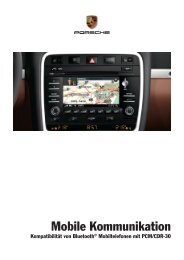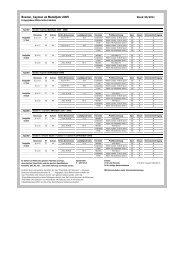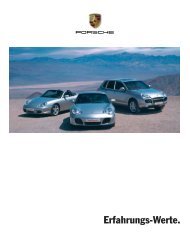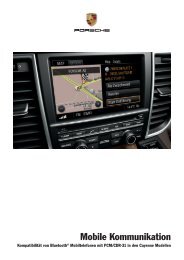You also want an ePaper? Increase the reach of your titles
YUMPU automatically turns print PDFs into web optimized ePapers that Google loves.
Radiofrequency radiation exposure<br />
Information<br />
This equipment complies with FCC radiation<br />
exposure limits set forth for an uncontrolled<br />
environment. This equipment should be installed<br />
and operated with minimum distance of 8 in.<br />
(20 cm) between the radiator and your body.<br />
This transmitter must not be co-located or<br />
operating in conjunction with any other antenna or<br />
transmitter<br />
Warning!<br />
Risk of accidents. Radar sensor vision can be<br />
impaired by rain, snow, ice or heavy spray.<br />
Vehicles in front will not be detected properly<br />
or may not be detected at all.<br />
f Do not use adaptive cruise control under these<br />
conditions.<br />
Warning message<br />
Adaptive cruise control can be deactivated<br />
automatically if the radar sensor is very dirty or<br />
iced up, obstructed , in unfavorable weather<br />
conditions (heavy rain) or when driving through<br />
tunnels.<br />
The message “Fault ACC sensor” will appear on<br />
the multi-function display in the instrument panel.<br />
For information on warning messages on the<br />
multi-function display:<br />
f Please see the chapter “OVERVIEW OF<br />
WARNING MESSAGES” on page 152.<br />
Notes<br />
This device complies with Part 15 of the FCC<br />
Rules and with RSS-210 of Industry Canada.<br />
Operation is subject to the following two<br />
conditions:<br />
1. This device may not cause harmful<br />
interference, and<br />
2. this device must accept any interference<br />
received, including interference that may<br />
cause undesired operation.<br />
Changes or modifications made to this equipment<br />
not expressly approved by Porsche may void the<br />
FCC authorization to operate this equipment.<br />
This equipment has been tested and found to<br />
comply with the limits for a Class A digital device,<br />
pursuant to Part 15 of the FCC Rules. These limits<br />
are designed to provide reasonable protection<br />
against harmful interference when the equipment<br />
is operated in a commercial environment. This<br />
equipment generates, uses, and can radiate radio<br />
frequency energy and, if not installed and used in<br />
accordance with the instruction manual, may<br />
cause harmful interference to radio<br />
communications. Operation of this equipment in a<br />
residential area is likely to cause harmful<br />
interference in which case the user will be required<br />
to correct the interference at his own expense.<br />
This Class A digital apparatus complies with<br />
Canadian ICES-003.<br />
Cet appareil numérique de la classe A est<br />
conforme à la norme NMB-003 du Canada.<br />
Operating principle of adaptive cruise<br />
control<br />
No vehicle detected in front – open road<br />
driving<br />
Adaptive cruise control operates like a cruise<br />
control system. The desired speed that was set is<br />
maintained constantly.<br />
Vehicle detected in front – driving in traffic<br />
If a vehicle travelling ahead of you in the same lane<br />
is detected as driving slower than the selected<br />
desired speed, adaptive cruise control will<br />
automatically maintain a set distance from the<br />
vehicle in front.<br />
If the vehicle in front stops, adaptive cruise control<br />
will slow your vehicle down to a stop provided this<br />
is possible within the control limits of the system.<br />
Adaptive cruise control actively keeps your vehicle<br />
at a standstill.<br />
If the vehicle in front drives off, automatic speed<br />
control and distance control can be resumed.<br />
Driving and Driving Safety 179




